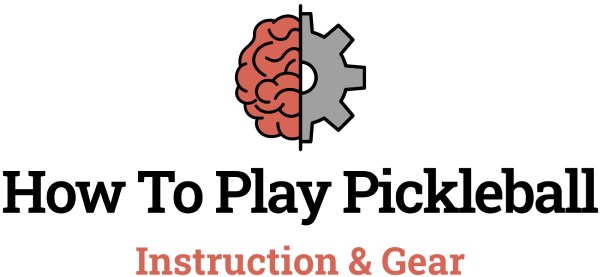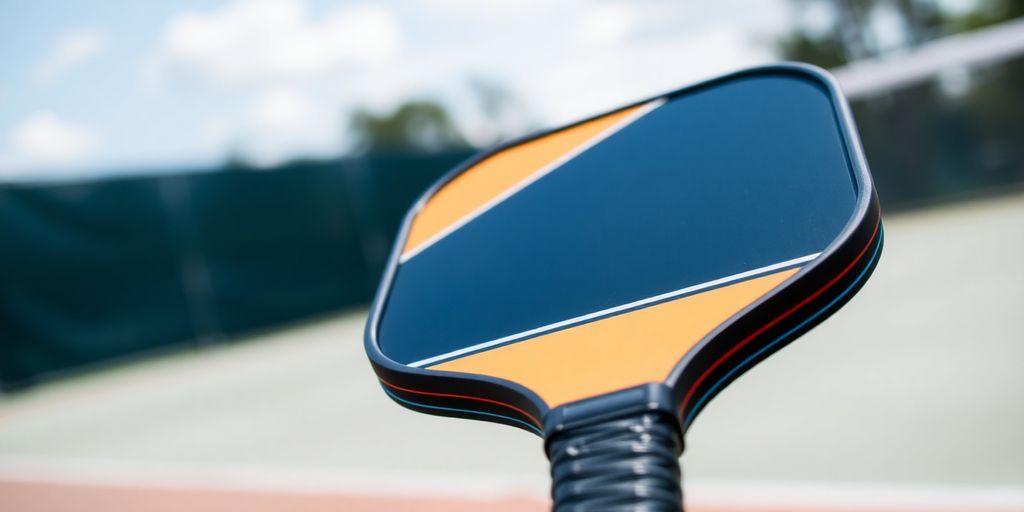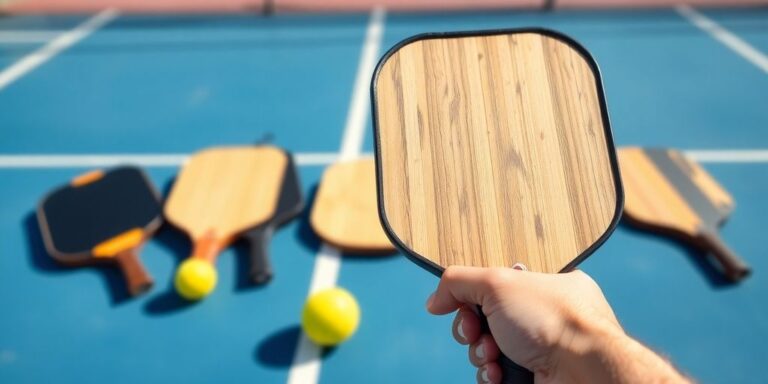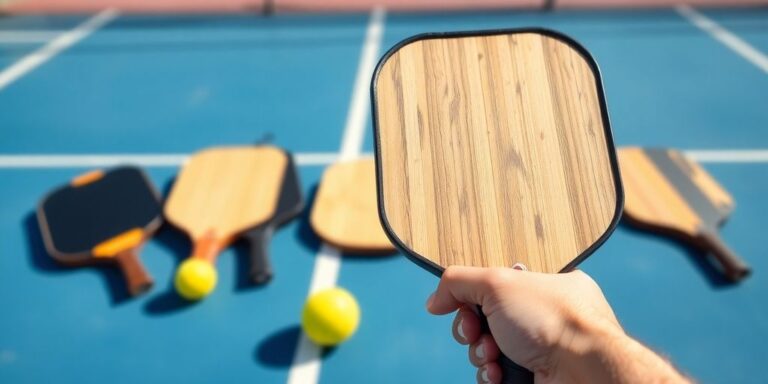Choosing the right pickleball paddle can really change the way you play. With so many options out there, it’s easy to feel overwhelmed. But don’t worry! Understanding what makes a good pickleball paddle can help you find the right one. This guide will walk you through important features that can enhance your game, from materials to grip size. Let’s dive into what you should look for when picking your paddle.
Key Takeaways
- Quality paddles improve your performance and help prevent injuries.
- Understanding the components of a paddle is crucial for making the right choice.
- Grip size and handle shape significantly affect your control and comfort.
- The materials used in the paddle’s surface and core influence power and control.
- Your playing style should guide your paddle selection for the best experience.
The Importance Of Quality In A Good Pickleball Paddle
It’s easy to think any old paddle will do when you’re starting out, but trust me, the quality of your paddle matters. A lot. It’s not just about hitting the ball; it’s about how well you hit it, how long the paddle lasts, and even how your body feels after a game. Investing in a good pickleball paddle is an investment in your game and your health.
Enhancing Gameplay Performance
A better paddle can seriously up your game. Think about it: better materials mean better control, more power, and a bigger sweet spot. You’ll be able to place your shots more accurately, react faster, and just generally play with more confidence. It’s like upgrading from a rusty old bike to a sleek, new roadster. The difference is night and day. With advanced materials, you can really see a difference in your gameplay.
Preventing Injuries
This is something people often overlook, but a quality paddle can actually help prevent injuries. Paddles made with good shock absorption and ergonomic design reduce the stress on your wrist, elbow, and shoulder. Trust me, tennis elbow is no joke, and the right paddle can help you avoid it. It’s all about finding a paddle that feels good in your hand and doesn’t cause unnecessary strain.
Long-Term Investment In Equipment
Okay, so a good paddle might cost a bit more upfront, but think of it as a long-term investment. Cheap paddles tend to break easily or lose their performance over time. A quality paddle, on the other hand, will last much longer and maintain its performance, saving you money in the long run. Plus, you’ll enjoy playing with it more, which is priceless. Consider premium pickleball paddles as a worthwhile investment.
Think of it like this: buying a cheap paddle is like buying a cheap car. It might get you from point A to point B for a little while, but it’s going to break down sooner or later. A quality paddle is like buying a reliable car that will last for years and provide a much better driving experience.
The Anatomy Of A Good Pickleball Paddle
It’s important to understand what makes up a pickleball paddle if you want to pick the right one. A good paddle isn’t just one solid piece; it’s made of different parts that all work together. Let’s break down what those parts are and why they matter.
Understanding Paddle Components
A pickleball paddle has three main parts: the handle, the face, and the core. The handle is what you grip, and it affects how well you can control the paddle. The face is the part you hit the ball with, and it determines how much power and spin you can generate. The core is the inside layer, and it affects the paddle’s overall feel and performance. Each component plays a vital role in the paddle’s overall performance.
Impact Of Paddle Face Material
The material used for the paddle face really changes how the paddle plays. Common materials include graphite, carbon fiber, and fiberglass. Graphite faces are known for giving you great control and a responsive feel. Fiberglass faces tend to offer more power and are pretty durable. Carbon fiber is a good middle ground, offering a blend of control and power. Choosing the right face material depends on what you value most in your game. If you are looking for the best pickleball paddles, consider the face material.
Role Of The Core In Performance
The core of a pickleball paddle is usually made from polymer or nomex. Polymer cores are popular because they offer a good balance of power and control, plus they tend to be quieter. Nomex cores are stiffer and provide more power, but they can also be louder. The core material affects how the paddle feels when you hit the ball and how much power you can generate. It’s a key factor in finding a paddle that suits your playing style. If you want to play pickleball well, you need to understand the core.
Think of the paddle’s anatomy like a car. The handle is the steering wheel, giving you control. The face is the engine, providing power. And the core is the suspension, affecting the ride’s smoothness and feel. All these parts need to work together to give you the best performance on the court.
Here’s a quick look at how different materials affect paddle performance:
| Material | Face | Core |
|---|---|---|
| Properties | Control, responsive feel | Balance of power and control, quieter |
| Properties | More power, durable | Stiffer, more power, louder |
Grip Size And Handle Shape

Finding The Right Grip Size
Okay, so finding the right grip size is actually a big deal. It’s not just about comfort, though that’s part of it. It’s about control, power, and even preventing injuries. Too small, and you might death-grip the paddle, leading to fatigue and potential tennis elbow. Too big, and you lose feel for the ball. I remember when I first started, I just grabbed whatever paddle looked cool. Big mistake! My hand was killing me after just a few games. Now I know better.
Here’s a quick guide:
- Measure your hand: Use a ruler to measure from the tip of your ring finger to the bottom crease of your palm. This gives you a good starting point.
- Consider your style: Do you like wristy shots? A smaller grip might be better. Do you prefer stability? Go for a larger one.
- Experiment: Try out different grips. Most shops will let you hold a paddle to get a feel for it. Don’t be afraid to add an overgrip to fine-tune the size. You can always increase the diameter of your grip easily.
> I've found that a slightly smaller grip, around 4 1/4 inches, works best for me. It allows for more wrist action and quicker reactions at the net. But everyone is different, so experiment to see what feels right for you.
Importance Of Handle Shape
Handle shape is another thing people often overlook. Most paddles come with a pretty standard shape, but there are variations. Some are more rounded, some are more rectangular, and some are even flared at the end. The shape affects how the paddle sits in your hand and how easily you can change your grip during a game. I personally prefer a slightly more rectangular handle because it gives me a better sense of where the paddle face is, especially during quick exchanges. Some players like to place a finger on the paddle surface for added control and paddle orientation; for these players, I recommend paddles with shorter handles.
Here’s what to think about:
- Rounded handles: These are generally more comfortable for players who like to switch grips frequently.
- Rectangular handles: These provide a more secure feel and can help with paddle awareness.
- Flared handles: These can prevent the paddle from slipping out of your hand during aggressive swings.
Comfort And Control During Play
Ultimately, the right grip size and handle shape come down to comfort and control. If you’re not comfortable, you won’t play well. And if you don’t have control, you’ll be spraying balls all over the court. Pay attention to how your hand feels during play. Are you gripping too tightly? Is the paddle slipping? Are you getting blisters? These are all signs that you might need to adjust your grip size or handle shape. Don’t be afraid to experiment with different pickleball grips and overgrips until you find something that works for you.
Here’s a table summarizing grip material considerations:
| Grip Material | Benefits | Best For |
|---|---|---|
| Cushioned | Extra comfort, reduced hand fatigue | Players seeking comfort |
| Tacky | Enhanced grip, prevents slipping | Players with sweaty hands |
| Perforated | Better ventilation, moisture management | Players in hot climates |
Surface And Core Materials
Choosing The Right Surface Material
The surface material of a pickleball paddle greatly impacts how the ball responds. You’ll find paddles with surfaces made from fiberglass, carbon fiber, or composite materials. Each offers a different feel and level of control. Carbon fiber is known for its lightweight and responsive qualities, making it a popular choice for players wanting more power and spin. Fiberglass offers a softer feel, which can be great for control and dinking. The number of layers and the way they’re put together also changes how the paddle performs. It’s not always clear-cut, but generally, more layers mean more durability and a different feel.
Benefits Of Composite Cores
Composite cores, often made of polymer or foam, are the heart of a pickleball paddle. Polymer cores have been around for a while and are still common. Foam cores are newer, showing up around 2025. The core material affects the paddle’s feel and how it plays. For example, a polymer core usually gives you a softer touch and more control, while other materials might offer more power. Foam cores tend to feel softer when you hit the ball and hold their shape longer, which means they might last longer too. The thickness of the core also matters. Thicker cores, like 16mm, are more stable, have a bigger sweet spot, and absorb more of the ball’s energy. Thinner cores, around 14mm, give you more feel for the ball and let you hit with more power.
Impact On Power And Control
The combination of surface and core materials is what really determines a paddle’s performance. The surface gives you spin and feel, while the core gives you power and control. A paddle with a carbon fiber surface and a polymer core might give you a good balance of both. But a paddle with a fiberglass surface and a different core might be better for players who want more control. It really depends on what you’re looking for in your game. Also, things like the size of the cells in the core and how thick the cell walls are can make a difference, but that’s something you usually only find out from detailed reviews. When picking a paddle, think about what you value most – power, control, or a balance of both – and then look for materials that match your needs.
Choosing the right materials for your pickleball paddle is a big deal. It’s not just about what feels good at first; it’s about how those materials will hold up over time and how they’ll affect your game in the long run. Think about your playing style and what you want to improve, and then pick a paddle that will help you get there.
Playing Style And Paddle Selection

It’s time to get real about how you play pickleball. Not how you want to play, but how you actually play. This is key to picking the right paddle. Are you a banger, a dinker, or somewhere in between? Let’s break it down.
Identifying Your Playing Style
Most players fit into a few categories: power players, control players, and all-around players. Power players love to smash the ball, control players are all about finesse and placement, and all-around players try to do a bit of both. Knowing which one you are (or aspire to be) is the first step. Beginners might not know their style yet, and that’s okay! Focus on getting a feel for the game first. As you improve your pickleball skills, your style will naturally emerge.
Matching Paddle Weight To Style
Paddle weight is a big deal. Heavier paddles (8-8.5 oz) give you more power, but they can be harder to control. Lighter paddles (7-7.8 oz) are easier to maneuver, giving you better control and faster reactions. Mid-weight paddles try to strike a balance. Here’s a quick guide:
- Power Players: Heavier paddles for maximum oomph.
- Control Players: Lighter paddles for precision.
- All-Around Players: Mid-weight paddles for versatility.
Choosing the right weight can also depend on your physical strength and stamina. Don't go too heavy if you tire out quickly!
Material Preferences Based On Play
The materials used in a paddle’s face and core also affect performance. Fiberglass faces tend to offer more power, while carbon fiber and graphite faces provide better control. Composite cores can offer a good balance of both. If you’re a control player, look for paddles with carbon fiber faces. If you’re a power player, fiberglass might be a better choice. Don’t be afraid to experiment with different materials to see what feels best for you. Also, consider the paddle shape. A widebody paddle is more forgiving.
Performance Features To Consider
When you’re trying to pick out the perfect pickleball paddle, it’s easy to get lost in all the details. But focusing on a few key performance features can really help you narrow down your choices and find a paddle that fits your game. Let’s break down some of the most important things to think about.
Weight Distribution
How the weight is spread out in a paddle can make a big difference in how it feels and performs. A paddle that’s head-heavy will give you more power, while a head-light paddle will be easier to maneuver. It’s all about finding the balance that works for you. Some paddles even have adjustable weight systems, letting you customize the feel to your liking. This is especially useful if you’re still figuring out your preferred style of play. You can also consider the paddle thickness to see how it affects the weight distribution.
Sweet Spot Size
The sweet spot is that magical area on the paddle face where you get the best response and feel when you hit the ball. A larger sweet spot means you’ll have more forgiveness on off-center hits, which is great for beginners or anyone who wants a little extra consistency. Smaller sweet spots can offer more control and power, but they require more precision. Here’s a quick comparison:
| Sweet Spot Size | Pros | Cons |
|---|---|---|
| Large | More forgiving, consistent hits | Less power and control on perfect hits |
| Small | More power and control on perfect hits | Less forgiving, inconsistent hits |
Durability And Warranty Options
Let’s face it, pickleball paddles can take a beating. You want something that’s going to last, so durability is key. Look for paddles made with high-quality materials like graphite or composite. Also, check the warranty. A good warranty shows that the manufacturer stands behind their product and is willing to replace it if something goes wrong. It’s peace of mind that your Engage Pickleball paddles will last.
Investing in a durable paddle is a smart move. Not only will it save you money in the long run, but it will also ensure that you have a reliable piece of equipment that you can count on game after game. Plus, a good warranty can protect you from unexpected defects or damage.
User Reviews And Recommendations
Learning From Other Players
When you’re trying to figure out which pickleball paddle is right for you, don’t underestimate the power of other people’s experiences. Reading user reviews can give you a real sense of how a paddle performs in different situations. People talk about everything – from how the paddle feels in their hand to how it affects their game. It’s like getting advice from a bunch of fellow players, which can be super helpful.
- Look for patterns in the reviews. If a lot of people say the same thing, it’s probably true.
- Pay attention to reviews from players with a similar skill level to yours. Their experiences will be more relevant.
- Don’t just focus on the good reviews. The bad ones can tell you a lot about potential problems.
Expert Insights On Paddle Choices
Beyond regular user reviews, it’s worth checking out what the experts have to say. Many websites and magazines do in-depth reviews of pickleball paddles, putting them through rigorous testing. These reviews can give you a more objective look at a paddle’s strengths and weaknesses. For example, you can find full paddle reviews online.
Importance Of Testing Before Buying
Okay, so you’ve read the reviews and listened to the experts, but here’s the thing: the best way to know if a paddle is right for you is to try it out yourself. What feels great to one person might not feel so great to you. See if your local pickleball club or store has demo paddles you can borrow. Some online retailers also have trial periods where you can return a paddle if you don’t like it. This is especially important if you’re considering investing in a high-end paddle. Also, consider the type of pickleball nets you play on, as this can influence your paddle choice.
Trying out a paddle lets you feel the grip, test the weight, and see how it performs with your swing. It’s a hands-on way to make sure the paddle matches your playing style and feels comfortable in your hand. Don’t skip this step if you can avoid it!
Check out what our users are saying! Their reviews and suggestions can help you make the best choice. Don’t miss out on their insights—visit our website now to read more and join the conversation!
Wrapping It Up
In the end, picking the right pickleball paddle can really change your game. It’s not just about grabbing the first one you see; you want something that fits your style and feels good in your hand. Think about the weight, grip size, and materials that work best for you. A good paddle can help you play better and enjoy the game more. So, take your time, do a little research, and find a paddle that feels just right. Happy playing!
Frequently Asked Questions
What should I look for in a good pickleball paddle?
When choosing a pickleball paddle, consider its weight, grip size, and materials. A good paddle should feel comfortable in your hand and match your playing style.
How does the paddle’s weight affect my game?
The weight of the paddle can impact your swing speed and control. Lighter paddles are easier to maneuver, while heavier paddles can provide more power.
What is the best grip size for my paddle?
To find the right grip size, hold the paddle and check if you can fit your index finger between your fingers and palm. A proper grip size helps with control and comfort.
How do materials affect paddle performance?
The materials used for the paddle’s face and core can influence power and control. Graphite and composite materials are popular for their balance of durability and performance.
Is it important to test a paddle before buying?
Yes! Trying out a paddle can help you feel its weight and grip, ensuring it matches your playing style and comfort needs.
What features should I consider for durability?
Look for paddles with good warranties and made from high-quality materials like fiberglass or carbon fiber, which can withstand regular play.




